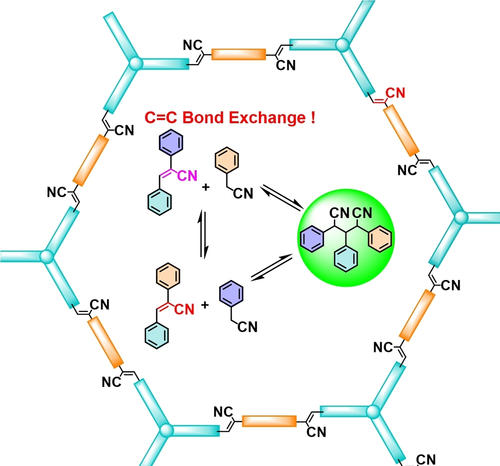Vinylene-linked two-dimensional conjugated covalent organic frameworks (V-2D-COFs), belonging to the class of two-dimensional conjugated polymers, have attracted increasing attention due to their extended π-conjugation over the 2D backbones associated with high chemical stability. The Knoevenagel polycondensation has been demonstrated as a robust synthetic method to provide cyano (CN)-substituted V-2D-COFs with unique optoelectronic, magnetic, and redox properties. Despite the successful synthesis, it remains elusive for the relevant polymerization mechanism, which leads to relatively low crystallinity and poor reproducibility. In this work, we demonstrate the novel synthesis of CN-substituted V-2D-COFs via the combination of Knoevenagel polycondensation and water-assisted dynamic Michael-addition-elimination, abbreviated as KMAE polymerization. The existence of C=C bond exchange between two diphenylacrylonitriles (M1 and M6) is firstly confirmed via in situ high-temperature NMR spectroscopy study of model reactions. Notably, the intermediate M4 synthesized via Michael-addition can proceed the Michael-elimination quantitatively, leading to an efficient C=C bond exchange, unambiguously confirming the dynamic nature of Michael-addition-elimination. Furthermore, the addition of water can significantly promote the reaction rate of Michael-addition-elimination for highly efficient C=C bond exchange within 5 mins. As a result, the KMAE polymerization provides a highly efficient strategy for the synthesis of CN-substituted V-2D-COFs with high crystallinity, as demonstrated by four examples of V-2D-COF-TFPB-PDAN, V-2D-COF-TFPT-PDAN, V-2D-COF-TFPB-BDAN, and V-2D-COF-HATN-BDAN, based on the simulated and experimental powder X-ray diffraction (PXRD) patterns as well as N2-adsorption–desorption measurements. Moreover, high-resolution transmission electron microscopy (HR-TEM) analysis shows crystalline domain sizes ranging from 20 to 100 nm for the newly synthesized V-2D-COFs.

Vinylene-linked two-dimensional conjugated covalent organic frameworks (V-2D-COFs), belonging to the class of two-dimensional conjugated polymers, have attracted increasing attention due to their extended π-conjugation over the 2D backbones associated with high chemical stability. The Knoevenagel polycondensation has been demonstrated as a robust synthetic method to provide cyano (CN)-substituted V-2D-COFs with unique optoelectronic, magnetic, and redox properties. Despite the successful synthesis, it remains elusive for the relevant polymerization mechanism, which leads to relatively low crystallinity and poor reproducibility. In this work, we demonstrate the novel synthesis of CN-substituted V-2D-COFs via the combination of Knoevenagel polycondensation and water-assisted dynamic Michael-addition-elimination, abbreviated as KMAE polymerization. The existence of C=C bond exchange between two diphenylacrylonitriles (M1 and M6) is firstly confirmed via in situ high-temperature NMR spectroscopy study of model reactions. Notably, the intermediate M4 synthesized via Michael-addition can proceed the Michael-elimination quantitatively, leading to an efficient C=C bond exchange, unambiguously confirming the dynamic nature of Michael-addition-elimination. Furthermore, the addition of water can significantly promote the reaction rate of Michael-addition-elimination for highly efficient C=C bond exchange within 5 mins. As a result, the KMAE polymerization provides a highly efficient strategy for the synthesis of CN-substituted V-2D-COFs with high crystallinity, as demonstrated by four examples of V-2D-COF-TFPB-PDAN, V-2D-COF-TFPT-PDAN, V-2D-COF-TFPB-BDAN, and V-2D-COF-HATN-BDAN, based on the simulated and experimental powder X-ray diffraction (PXRD) patterns as well as N2-adsorption–desorption measurements. Moreover, high-resolution transmission electron microscopy (HR-TEM) analysis shows crystalline domain sizes ranging from 20 to 100 nm for the newly synthesized V-2D-COFs.
